Large Mass Stellar Death
What's covered here:
- How do massive stars end their lives?
- What happens when a star becomes a supernova?
- What are the characteristics of a supernova?
- What are some famous supernovae of the past?
The fates of large mass stars are quite different from those of the low
mass ones. At first glance you might think that with more mass they
will
live longer - but no, they are just fuel guzzlers. As such, massive
stars (O and B types on the Main Sequence) will have very short lives.
To get a good idea of how a large mass star dies, let's look at what a
really big one goes through.
Very massive stars are also very luminous, so they tend to have very
strong stellar winds (since this is linked to their energy outputs).
Due
to this they may have a lot of gas around them that was blown off long
ago. Sometimes it is easy to see these gas clouds, sometimes not. Like
other mass ejection things we have already seen, the material can be
spewed out in several ways, with the most common being bipolar outflow and rings. Figure 1
shows several different stages in the life cycle of stars, all in one
convenient location.
 Figure 1.
A picture from the Hubble Space
telescope
showing stars in various stages of their lives. The lower right region
(1) is a gas cloud from which stars form. Near the center (2) is a
group of main sequence stars. Up and to the left of those is a large
star (3) in the process of dying. The massive star has already ejected
a ring of material as well as material out from it in a bipolar
direction. In a way this image is just like a family portrait showing
the oldest and youngest members of a family. Image credit: Wolfgang
Brandner (JPL/IPAC), Eva K. Grebel (Univ. Washington), You-Hua Chu
(Univ. Illinois Urbana-Champaign), and NASA.
Figure 1.
A picture from the Hubble Space
telescope
showing stars in various stages of their lives. The lower right region
(1) is a gas cloud from which stars form. Near the center (2) is a
group of main sequence stars. Up and to the left of those is a large
star (3) in the process of dying. The massive star has already ejected
a ring of material as well as material out from it in a bipolar
direction. In a way this image is just like a family portrait showing
the oldest and youngest members of a family. Image credit: Wolfgang
Brandner (JPL/IPAC), Eva K. Grebel (Univ. Washington), You-Hua Chu
(Univ. Illinois Urbana-Champaign), and NASA.
Sometimes the outflow is even more energetic and at times confusing
to astronomers. Some very massive O-type stars have such strong winds
that they can completely screw up their evolutions - they lose so much
mass that you have to take that into account in your calculations when trying to figure out
how these stars will live their lives. Due to this uncertainty, we have
a rather hard time predicting what a very massive star will do or even
trying to figure out what one of them may have done in the past. Images
of two such objects are shown in Figure 2.
A recently observed massive star (with the exciting name of WOH G64)
has lost so much material that a thick, dusty ring has formed around
it. This star is very far away, in another galaxy in fact, so it
is not possible to easily see the ring, but its presence is revealed
by spectra and other instruments. You can learn about this massive
star here.
Even though it has lost a bunch of material, WOH G64 is still about 1500 times
wider than the Sun.
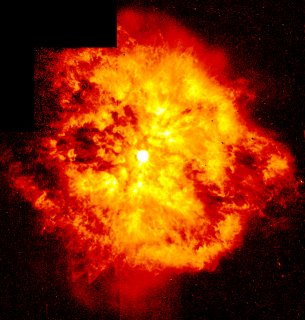 |
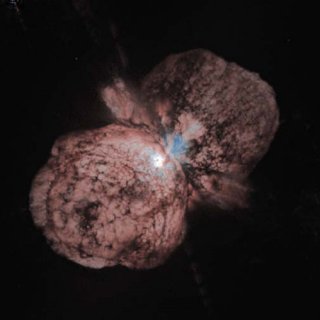 |
| Figure 2. Two very massive stars with very extreme
mass loss episodes. On the left is the star WR124, a massive star
ejecting material out at speeds of 100,000 miles/hr. Each blob of gas
that it ejects out has a mass of more than 30 times that of the
Earth's. To the right is the unusual star Eta Carina. Actually, the
star
is buried in the center of the two bubbles, which are thought to be
from an eruption that occurred in 1847.
Follow this link
to see how the bubbles formed. During this outburst the two
bubbles were ejected as well as a disk of material that can be seen
between the bubbles. The speed of the material in this case is on the
order of 1.5 million miles/hr. Image credits: Yves Grosdidier
(University of Montreal and Observatoire de Strasbourg), Anthony Moffat
(Universitie de Montreal), Gilles Joncas (Universite Laval), Agnes
Acker
(Observatoire de Strasbourg), Jon Morse (University of Colorado), and
NASA. |
All of these big time mass loss episodes are just a sneak preview of
what is to eventually happen to these stars. These stars are more
massive than the cut off for going into Planetary Nebula stages, so the
death scenarios of the massive stars go down very different paths.
Just how big can a star be? We're not exactly sure, but there is a limit
to how much material can come together to form a single star, and
conservative estimates put that at around
150 solar masses.
However in 2010 astronomers from the Very Large Telescope in Chile
announced the discovery of a star that may have a mass that is currently
265 times the mass of the Sun. What
is really amazing about this star, with the cute name R136a1, is that it
started out with a mass of about 320 solar masses! So it probably had some
serious mass loss episodes in its life. In case you were wondering, this star is
not even in our galaxy, but is in a neighboring galaxy.
We'll look at the life cycle of a 25 Solar
Mass star to see what happens to one of these big beasts. It is
more massive, so it can go through more burning stages than a low mass
star. It can ignite the more massive elements due to the greater
gravitational heating in the core (more mass means more gravity). Each
burning stage takes less time. The data in the accompanying table is
from Chieffi, Limongi, and Straniero (1998) based upon their computer
model for such a star.
| Fusion Process |
Main Fusion Products |
Duration of Fusion Process |
| H |
He |
6 million years |
| He |
C, O |
700,000 years |
| C |
Ne, O |
1000 years |
| Ne |
O |
9 Months |
| O |
S, Si, Ar |
4 Months |
| Si |
Fe, Cr |
1 day |
When the star is burning hydrogen, it is on the Main Sequence. Every
other burning stage after that has the star off the Main sequence and
in the area of the H-R diagram populated by Supergiants. The stars just evolve
through these various burning stages while they are Supergiants,
sometimes blue supergiants, sometimes yellow supergiants,
and sometimes red supergiants, so they will
wander back and forth across the top of the H-R diagram during these
later stages. If you click here you can see
some evolutionary paths of such stars. The region that the supergiants
inhabit isn't a clearly defined location on the H-R diagram, but is
basically just the top part where the luminosity is very high.
Take a look at the numbers in the rightmost column.
Why is each stage shorter than the previous stage? There are two reasons
- There is less fuel available in each stage. After all, stars are
originally made up of mainly hydrogen and helium, so all of the other
material comes for the most part from previous burning stages. Only a
fraction of the original star is made up of the elements heavier than
hydrogen and helium that are used in the later burning stages.
- There is lower efficiency in the later burning processes. Less energy is
released when heavier elements are undergoing fusion, so the star needs
to burn that material at a greater rate to produce enough energy to
sustain the structure of the star (to maintain stuff like Hydrostatic
and Thermal Equilibrium).
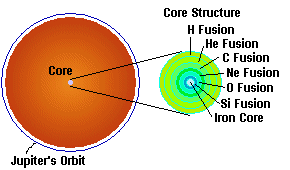 |
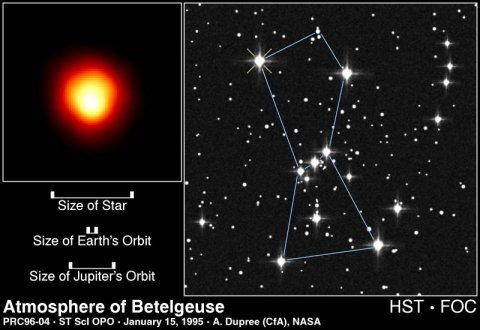 |
| Figure 3.The structure of the interior of a
supergiant star when it finishes silicon fusion. The very center has
the inert iron core, and it is surrounded by thin layers of fusion
shells. The core size is actually exaggerated a bit here. It is
actually only 1/1000 the radius of the star (about the radius of our
Sun), but it contains about 1/3 of the star's mass (around 8 solar masses for
a 25 solar mass star). Note how the radius of the star stretches out to
the size of Jupiter's orbit. Obviously we wouldn't want a star like
this in our neighborhood. |
Figure 4. Betelgeuse - a truly giant supergiant.
The
shoulder star of Orion is so large that its size can actually be seen
in the Hubble Space Telescope (most stars are so far away that they
always look like dots unless they have a really huge diameter, like
this one). Image credit: Andrea Dupree (Harvard-Smithsonian CfA),
Ronald Gilliland (STScI), NASA and ESA. |
So now these dying massive stars will be seen as
either Red Supergiants or Blue Supergiants, depending upon
how hot or cool they are. Due to their very large radius they also tend to be
extremely luminous. How large can the radii get?
In 2005, astronomers discovered
several red supergiants with radii that were much larger than that of
Betelgeuse (shown above) - these stars had radii that are about 1500
times that of the Sun! To see how big these stars actually are,
just take a look
here. Obviously with the outer layers so stretched
out, the fusion going on deep in the core is not going to be visible to
anyone. Even though stars like this look like they are in the last stages
of their lives, we can only see what is going on at the surface, not
what is actually happening in the core. Of course the core is the
interesting part!
Eventually the core of the massive star will look like a giant onion,
with the densest material in the middle and the lowest density stuff on
the top. Each shell of the onion will have some small amount of fusion
still going on, but the energy that is being produced at this point is
pretty pathetic.
All sorts of elements have been burning, and now we come to the last
element to burn, iron (Fe). Does it burn? It sure does, but at a cost.
Whereas previous fusion processes released energy, iron burning
consumes
energy. The energy that should go into holding up the star instead goes
into burning the iron. Is this a problem? You bet your buttonhole it
is! The iron fusion consumes energy, so there isn't enough energy to
help support the star. Without support, gravity comes along and
squeezes down the core. What happens when you squeeze stuff? It gets
hotter. The iron core gets hotter and starts burning faster, which
causes more energy to be sucked away, which removes more support
against gravity, which causes the core to compress more and heat up
more, which causes the iron to burn faster, which... I think you get
the
picture.
The core of the star collapses during the iron burning stage (since
nothing is fighting the gravity), which takes only about 1/4 second.
The
collapsing process shrinks the core down to the size of the Earth. It
gets very dense, up to the point of electron degeneracy (remember,
that's what a white dwarf is like). Will the collapse stop? No, since
the core is more massive than the Chandrasekhar limit (the iron core is
about 1.5 solar masses in this case). The mass of the core is too much
for the Chandrasekhar limit, so electron degeneracy will not stop the
collapse - it will keep going. Gravity keeps crushing the star down
until it reaches the point where the pieces of atoms are crushed
together. This is not an easy thing to do, but as the protons (p+) and
electrons (e-) are slammed together they form
neutrons (n) and neutrinos ( ), which
can be written out as
), which
can be written out as
p+ + e -  n +
n + 
This reaction makes sense, because you
combine a positive and a negative together and just get neutral stuff
out in the end. All of this compression and atomic mushing results in
the core of the star ending up as a big ball of neutrons. At this point
the collapse can be stopped by neutron degeneracy (1014
g/cc is the density of such material). Neutron degeneracy is much more
extreme than electron degeneracy - greater density, more extreme rules
of physics and so forth. Because of the degeneracy, the star will not
get any denser so long as the neutron degeneracy can hold it up. In the
case where the degeneracy can't hold it up, you end up with a black
hole - more on this later.
The core that ends up as a ball of neutron degenerate material is
called a Neutron Star. This is a star so small and compact
that a 1.5 solar mass neutron star would be only about 20 km in size.
Think of that - an object more massive than the Sun only the size of a
large city! It would be incredibly dense, 1014 gm/cc. This
is
sort like the density you'd get if you took 100 aircraft carriers and
crush them down to the size of a sugar cube. Try putting that in a cup
of tea!
In about 1/4 of a second the core has been crushed down, resulting
in a neutron star, which are in most cases only a few solar masses in size.
What happens to the rest of the star? Remember, the neutron star core
at this point is only a small part of the total mass, so you still have
quite a few solar masses to watch out for that is located beyond the
star's core.
The core collapsed very quickly from a size close to that of the
Sun's to only about 20 km, so there is a gap in the support of the rest
of the star. What support? - there is NO SUPPORT! Nothing is holding up
the rest of the star. This is sort of like when the Coyote runs off a
cliff and doesn't immediately fall down - at least not until he
realizes
that he is off the cliff. The outer layers of the star don't really
know that they have had their legs cut out from under them for a
moment, but once they do - watch out. The upper layers will fall onto
the ultra dense neutron degenerate core and the material will heat up
to
about 5 billion degrees. This high temperature and the corresponding
high pressure will generate an incredible amount of energy. The energy
that is generated by the slamming of the outer layers on the core is
huge. This energy that is produced here in this small interval of time
is the same amount as that given off by the Sun over its entire
lifetime
(10 billion years). This huge bottled up energy is released in a
massive explosion that will blow off the outer layers - basically, the
star explodes. That's how you produce a Supernova. This little animation
shows a blue supergiant quickly collapsing down and then exploding as a
supernova.

What is a supernova like? Here are some of its main characteristics -
- The explosion blows away almost all of the mass of the star.
What is left behind may be only a few solar masses in size, though in the
case of a black hole it can be larger.
- The core that is left over is in the form of a neutron star or a
black hole.
- There is the release of a large amount of energy, so these things
are very bright. A supernova produces the equivalent amount of energy
as an entire galaxy (billions of stars), and it can stay bright for
quite some time - weeks or months depending upon the distance. There
have even been supernovae that were visible in the daytime.
- The iron fusion and the huge amount of energy from the collapse
of the star are so great that the fusion of even heavier elements
occurs. All elements more massive than iron require huge amounts of
energy to form, since like iron, their fusion processes consume energy.
A supernova is the only thing that has energy to spare for the fusion
of the heavy elements, so this is the only way that these things can be
made. All of the copper, zinc, nickel, gold, silver, mercury, and other
elements up to uranium are produced in supernovae (these include
elements numbers 27 to 92 on the periodic table). The NuSTAR x-ray
satellite has been studying the chemical distribution of material from a supernova
that occurred only a few hundred years ago, some of this material is still
radioactive.
- During the formation of the neutron star there is the release of
neutrinos, and at times these can be detected. Remember, there are
neutrino detectors that are currently working to detect neutrinos from
the Sun and these detectors are able to pick up supernova neutrinos
as well.
- A large shock wave is produced by the explosion. The shock wave
can travel through space and can compress gas clouds, which will lead
to new star formation. This can help explain why large scale star
formation can continue on, since large stars die relatively quickly,
usually near to the location where they were born. If one dies in a
supernova near the location of its formation (near a Giant Molecular
Cloud), the shock wave from the explosion can ignite new episodes of
star formation in the GMC. The death of one star can lead to the birth
of many more. Recent observations by the Spitzer telescope appear
to support this scenario, with a region of star formation found
near a likely supernova - you can see a schematic of the event
here. Some people have even linked the
explosion of supernovae to things on the Earth, such as climate
changes or various large extinction events - but those are only theories.
Massive stars are pretty rare, so on average there is only one
supernova occurring in a galaxy every century.
Now I'm going to complicate matters a bit. There are actually
two main types of supernovae. One is the type that I just described; the
other occurs when a white dwarf is near its mass limit (the good old
Chandrasekhar limit=1.4 solar masses) and is pushed over this limit
when
too much mass is dumped on it, usually in a binary system. You may want
to refresh your memory on the stuff about novae in the previous set of
notes. If the white dwarf star in the binary system is really big
(close to 1.4 solar masses), rather than just going nova when mass is
dumped on it, it will be too massive to hold itself up and may instead
become a supernova. There is also a theory that if you had two white
dwarfs in a binary system and they collide, it will become a type I
supernova. Either way, the white dwarf ends up being too massive
and collapses in on itself.
Since there are two vastly different kinds of supernovae
- and they have to be distinguishable, and they are, mainly because the
object that explodes in each case is very different (massive star
versus white dwarf). To distinguish between the two types, the
following designations are given
- Type Ia Supernova - a white dwarf going over the
Chandrasekhar Limit
- Type II Supernova - a massive star collapsing and then
exploding when iron fusion starts
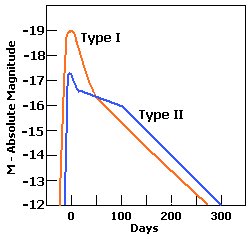
Figure 5. The
light curves of the different types of supernovae are shown - note that
the Type Ia supernovae are brighter. Also, the rate at which they
brighten and fade away is different. This helps astronomers distinguish
the two types. This graph uses absolute magnitude as the brightness scale since
the corresponding luminosity values are around a few billion solar
luminosities. |

Figure 6. The spectra
of the different types of supernovae are shown. The Type Ia supernova
has absorption (the valleys) and emission features (the peaks)
associated with heavy elements, while the Type II has only hydrogen (H and
H
and
H )
showing up prominently in its spectrum. Spectra for supernovae are available from
the Weizemann Interactive Supernova Data Repository. )
showing up prominently in its spectrum. Spectra for supernovae are available from
the Weizemann Interactive Supernova Data Repository. |
In general Type Ia supernovae are brighter by about two magnitudes or
so than the Type II. You would have to know the distance to the supernova if you want to
use the brightness as a way of categorizing it, so that isn't a good
method. Fortunately it is possible to tell the two supernovae apart by
looking at their spectra. The object that goes supernova is quite
different in each case, so the spectrum from each type of supernova is
distinct. A white dwarf is the burned out core of a dead star, so it
is made mainly of stuff like carbon, oxygen, nitrogen, etc., but not a
lot of hydrogen. A massive star, on the other hand, is still mainly
made
of hydrogen, so when it explodes its spectrum will be full of hydrogen.
It is pretty easy to distinguish the two types of supernovae without
knowing their distances. You'll notice that if you do know which type
of supernova you have, you can then use its typical maximum brightness
(from Figure 5 above) and the apparent magnitude that you observe to
get its distance.
One very unusual Ia supernova is 2006gz. This has a spectrum just like a 'regular'
Ia, but it was brighter than normal. It also had too much carbon and silicon, which led
some astronomers to speculate that this was actually a collision of two white dwarfs. It has
also been proposed that 2006gz came from a super-Chandrasekhar limit white dwarf - an abnormally
large white dwarf. So far we do not know the answer to this unusual question, but it does
show that sometimes very strange things do happen. There was also a recent study
by the
Chandra observatory that seemed to indicate that most type Ia supernovae
are actually produced by the merger of two white dwarfs, rather than a single star. So
until more evidence is found (because that's how science is done), we'll just have to use the
general phrase "white dwarf going over the mass limit" - which could occur due to very
different reasons.
You should be asking yourself Why is it 'Ia'? Why not just call it a 'I'?.
Good question. A type I supernova has very little hydrogen in the spectra, but
sometimes it is not because the star that exploded was a white dwarf. There are
two other type I supernova, with the amazingly original names of Ib
and Ic. Both are thought to come from large mass stars that have blown away
most of their outer layers so there is not much hydrogen left in their spectra.
The main difference between Ib and Ic is whether there is any helium left - a Ic has
no helium in their spectrum, while a Ib still has some helium. Both the Ib and Ic
are fainter than a Ia, and a bit rare since they only come from very massive stars.
Unlike the massive stars involved in the type II supernova, these have lost too much
of their mass to have a big blast. Generally when we talk about type I supernovae, we
are referring to type Ia.
Recently astronomers have found that there are some supernovae that
could be better described as super-supernovae - but that's sort of a silly
name. The term hypernovae has been proposed for these extreme
explosions. There is a bit of debate as to exactly what happens during
a hypernova, since this is a relatively new idea and most of them
have only been observed to occur at very great distances. One option is that
a very massive star (more than 30 solar masses, possibly up to 150
solar masses) that had been previously
losing mass eventually collapses in on itself, causes a massive
explosion and eventually forms a black hole. Another option is the
merger of unusual stars, such as two neutron stars, which results in a
massive explosion (you'll learn more about neutron stars
in the next set of notes).
One side effect of such an event is the emission of a large amount of
gamma-rays, which aren't normally observed from stars. Now a days such
gamma-ray bursts can be spotted with the Swift
telescope, and several possible
hypernova have been discovered in that way -
though it wasn't until after we look at
them with other telescopes, light visible light or x-ray telescopes
are we certain about their
overall energy output. The overall energy of a hypernovae
is generally 100 times greater than the energy given off
by "normal" supernovae. Currently the record holder for the most
powerful stellar explosion is the object known as SN2006gy (yes,
that is a lame name), which was observed in 2006 and had an energy output
that was greater than any other supernova.
Here is a comparison of this objects brightness over time compared to
other "normal" supernova. This is similar to Figure 5 shown above.
Here is an animation showing the explosion based
upon the x-ray and gamma-ray data from the region following the explosion.
It is interesting that there are two large bubbles of material, which were
given off by SN2006gy before the explosion occurred. This is
very similar to what we see today in Eta Carina (Figure 2), an object in
our own galaxy which might someday erupt as a hypernova. Several other
stars are thought to have also had smaller outbursts before they blew themselves
to pieces as supernova - sort of a hiccup before a really big belch! And in case
you were wondering how you missed such an amazing explosion in 2006,
don't worry, not too many people noticed it since SN2006gy occurred
in a galaxy that is about 240 million light years away, so it was barely
visible, except with the largest telescopes.
While most gamma-ray bursts are invisible to us (since gamma-rays cannot
reach the surface of the Earth), it is still possible to "see" them, since
the total energy given off is huge. Gamma-ray bursts give off light at all
wavelengths, not just gamma-rays (remember hot objects give off light at many wavelengths
even though they have only one peak for their emission). So when the Swift
satellite observes a burst, the location is transmitted to regular ground based
telescopes, both visible light and radio, in an effort to measure the light
output in as many wavelengths as possible. In March 2008, there was a gamma-ray
burst that was so powerful and concentrated that it could have been seen by
the naked eye for about 15 seconds. That's pretty impressive considering that
the object that produced the burst was about 7.5 billion light years away! A
gamma-ray burst in 2013 was so long lasting as well as powerful that it broke
records for total output. The 2013 burst lasted for hours, which is very
unusual for such events. But it was at a great distance away, so you wouldn't
have noticed anything.
Supernovae are sort of rare, so astronomers are only able to observe
them occurring in distant galaxies. Currently about 200 or more
supernovae are observed each year in other galaxies - in 2003, nearly
330 supernovae were discovered, some nearly a billion light-years away.
While this may seem okay, the problem is that since these are very
distant supernova, there isn't a lot of detail visible. For the most
part, astronomers can figure out the type of supernova in a distant
galaxy by obtaining a spectrum, but that's about all. Astronomers over
the centuries have seen supernovae, some in our own galaxy, though in
the old days they didn't know what they were. By looking at the records
of various cultures, astronomers have figured out that some unusual
astronomical events that mystified people in the past were actually
supernovae. Here are some of the more famous ones -
- 1054 A.D. - Chinese and Arabic astronomers observed a new star
appear in the constellation of Taurus the bull - this is a very
important supernova and we'll run across it later.
- 1572 A. D. - Tycho Brahe made careful observations of one in the
constellation of Cassiopeia
- 1604 A. D. - Johannes Kepler (and many others) observed one in
the constellation of Ophiuchus
Kepler's supernova (as it is sometimes called) was the last supernova
that was observed to go off in our galaxy. We haven't seen a star
become
a supernova in our galaxy in about 400 years - we're long overdue for
one! Of course, it is possible that other supernovae have occurred in
our galaxy since Kepler's, but they may have happened in distant parts
of our galaxy, and we couldn't see them. As you'll see there is good
suspicion that this is the case.
While it is difficult to see a supernova in great detail today (since
most are so far away), it is sometimes easy to find the material left over from
the explosion. This is because there is not only a lot of material, but
it stays relatively hot for quite a long time. The gas cloud left over
from the supernova explosion is known as a Supernova Remnant (SNR). Like an explosion in a
fireworks display, it takes a long time for the cloud to fade away,
though in the case of a SNR, the cloud can hang around for thousands of
years.
 |
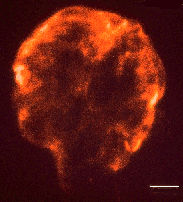 |
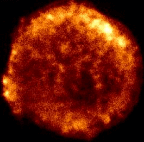 |
| Figure 7. Various Supernova Remnants
are
shown. To the left is the Crab Nebula, the remnant from the Supernova
observed by the Eastern astronomers in 1054 A. D. This visible light
image is from the Very Large Telescope. In the center is the Cygnus
loop, as seen by an x-ray telescope. This is a very old remnant, and it
is also very large. The line in the lower right part of the picture is
the width of the Full Moon. On the right is an x-ray image of the
remnant that was Tycho's supernova (observed in 1572 A. D.). If you
click on the Crab or Tycho images, you'll be able to see the
Chandra x-ray image of those remnants. (Image
credits: VLT, ROSAT, MPE, NASA, NASA/CXC/ASU/J. Hester et al.,
NASA/CXC/Rutgers/J. Warren & J. Hughes
et al.). |
These aren't just neat things to observe; they can provide useful
information about supernovae. This is done by measuring the velocity of
the gas and combining that with the size of the object. Doing this
provides astronomers with the age of the supernova (since velocity =
size / time since explosion). Even though we might not have seen the
explosion, we can estimate when it occurred. Many SNRs seen today are
still rather hot even though they may have "gone off" hundreds of years
ago. They often have x-ray emissions - which tells us that they are
still really hot. The supernovae described earlier, like the one in
observed in 1054 and those seen by Kepler and Tycho, all left behind
large expanding gas clouds. The one seen in 1054 can be observed today
as an object called the Crab Nebula (or, by its catalog name, M1).
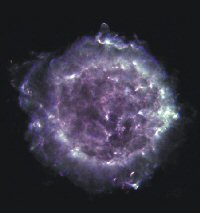 |
 |
Figure 8. Cas A, a supernova remnant. The image to
the left is from the Very Large Array radio telescope (NRAO). The
image to the right is from the Chandra x-ray telescope
(NASA/CXC/MIT/UMass Amherst/M.D.Stage et al). Click on either image to see a
larger view. |
One rather confusing SNR is Cas A,
a SNR in the constellation of Cassiopeia (that's where the "Cas" comes
from in its name). This is a very strong radio source, as well as a
strong x-ray source (see Figure 8). Obviously it is still rather hot.
It is also relatively small. Combining this information with velocity
and size data tells astronomers that this object blew up about 300
years ago. We haven't seen a supernova in our galaxy for about 400
years! Somehow, this thing blew up and no one noticed it!
It also looks like we missed another supernova that was even more
recent - only 150
or so years ago! Unfortunately it was in a rather messy part of the galaxy,
so it would have been difficult to see even if we knew it was going on.
Another neat SNR is the Gum
Nebula. This is a large gas cloud, and it is really large because
it is really old. It is estimated that this object blew up sometime
around 10,000 BC. Not only is it rather old, but it is also relatively
nearby. Taking this into account, when this thing blew up, it would
have been as bright as the Full Moon!
Let's see what we have got so far. Astronomers can study supernovae
in other galaxies, but they are so far and faint that only the largest
telescopes we have can see most of them. They can study supernova
remnants to try to figure out what happened in the past when these
things blew up. That's sort of boring, eh? It isn't all of the time.
Actually, things in the astronomical community got rather crazy not too
long ago, on February 23, 1987, to be exact. On that night there was
the
event of a lifetime - Supernova 1987A, or SN 1987A for short.
Supernovae are named for the year (1987 in this case) and a letter for
the order of their occurrence in the year. The first one of the year is
A, the second is B, etc. In 1987, the first supernova seen was labeled
SN 1987A.
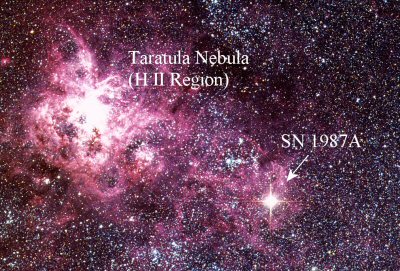 Figure 9.
Supernovae 1987A - image of the supernova at its brightest in the part
of the sky it appeared in. In the upper left of the image is the
Tarantula nebula, a large H II region. These objects are actually
thousands of light-years away - around 160,000 light-years in fact.
Image ESO, click on
the link to see the larger version of the image.
Figure 9.
Supernovae 1987A - image of the supernova at its brightest in the part
of the sky it appeared in. In the upper left of the image is the
Tarantula nebula, a large H II region. These objects are actually
thousands of light-years away - around 160,000 light-years in fact.
Image ESO, click on
the link to see the larger version of the image.
What was the big deal about SN 1987A? This was the first naked eye visibility supernova
observed since 1604 - you didn't need a telescope to see it; that's how
bright it was! While it did not occur in our galaxy, but in one of our
neighboring galaxies (the Large
Magellanic Cloud is the galaxy it happened in), it was still
close enough that detailed studies of it could be carried out. The
supernova was discovered, or perhaps a better word is "noticed," by Ian
Shelton on the night of Feb 23, 1987. It is quite likely that others
saw it but they did not recognize it for what it was.
When SN1987A went off, virtually every telescope that could observe
it was used to study it. This included telescopes located in countries
such as Chile, South Africa, and Australia, mainly because the Large
Magellanic Cloud and the supernova are very southern objects.
Satellites
were also used - including the ultraviolet satellite, IUE (which made
over 600 observations) and a variety of rockets that obtained x-ray
images. The Hubble Space telescope wasn't in orbit at the time, but it
has been looking at it since.
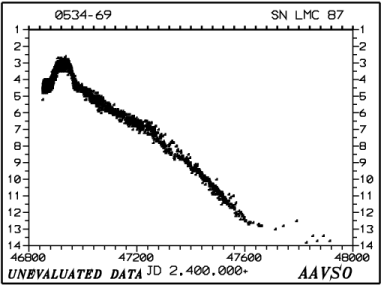 Figure 10.
The brightness variation of SN1987A over time. This chart shows
thousands of observations by both professional and amateur astronomers.
The time scale at the bottom is in days, but uses a rather strange
system. The entire graph covers a time corresponding to about 3.3
years. The magnitude scale is on the sides. Remember, the faintest that
you can see with your eye is magnitude 6, so SN1987A was visible to the
naked eye for about a year. Chart is courtesy of the American
Association of Variable Star Observers (AAVSO).
Figure 10.
The brightness variation of SN1987A over time. This chart shows
thousands of observations by both professional and amateur astronomers.
The time scale at the bottom is in days, but uses a rather strange
system. The entire graph covers a time corresponding to about 3.3
years. The magnitude scale is on the sides. Remember, the faintest that
you can see with your eye is magnitude 6, so SN1987A was visible to the
naked eye for about a year. Chart is courtesy of the American
Association of Variable Star Observers (AAVSO).
Another added advantage to this supernova over others that are
studied is that we knew which object blew up. This area of the sky is
fairly well studied, so many stellar surveys were done and the star in
question, Sanduleak -69 202,
was cataloged and its characteristics (color or temperature and
luminosity) were known before it became a supernova. Why was that
important? We knew what type of star exploded (temperature, luminosity,
likely mass, composition, etc.), so information about it helped
astronomers refine computer models of supernova events. The supernova
was bright for a long time (visible to the naked eye for about a year),
so its evolution was followed closely (and still is being followed) to
see if our theories about supernova remnants are correct. The rate at
which the supernova brightened and is fading away can also provide
information for various computer models and can be compared to
other
supernovae.
The spectrum of the explosion confirmed the heavy element production
(elements heavier than iron). This was seen in the way that various
elements would appear and then decay over time. This was exactly in
line
with the theories about the heavy element production - a nice example
where the theories that have been around for a long time finally were
supported by observations. Also, by measuring the expansion velocity,
we can determine the distance to the Large Magellanic Cloud galaxy in a
very accurate manner - something that is very difficult to do. Probably
one of the more exciting discoveries was of the neutrinos from the
supernova. All of those neutrino detectors around the world were set up
to look for neutrinos from the Sun. On the day of the supernova, these
detectors were practically flooded with neutrinos. By "flooded" I mean
they detected maybe six or eight neutrinos, which is considered a flood
when compared to the normal number of neutrinos that are detected. This
was another case of theory and observations coming together!
When you look at the supernova today, you can see several rings of
material around its location. This material is not part of the
supernova
explosion, but was blown off by the star years before (you may want to
go back up to the top of the notes to look at those big stars that are
currently blowing off mass, especially Eta Carina). It wasn't until the
supernova went off that the ring actually did something - in this case
the rings lit up, because the light (energy) from the supernova
traveled through them and heated up the gases.
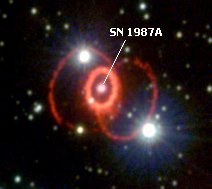 Figure 11.
How the area around SN 1987A looks today. The supernova is in the
center
of the multi-ring structure. The inner ring is less than a light-year
from the supernova, while the other rings are a few light-years away.
The rings are not part of the supernova, but are made of material that
was blown out from the star before it went supernova. To see why the
rings have the orientation that they do, just click on this link. Image credit: P. Challis (CfA).
Figure 11.
How the area around SN 1987A looks today. The supernova is in the
center
of the multi-ring structure. The inner ring is less than a light-year
from the supernova, while the other rings are a few light-years away.
The rings are not part of the supernova, but are made of material that
was blown out from the star before it went supernova. To see why the
rings have the orientation that they do, just click on this link. Image credit: P. Challis (CfA).
Today the supernova is too faint to see with the eye, but its
evolution is still being followed, particularly what is going on with
the rings around it. The distance from the supernova to the nearest
ring is less than a light-year. The shock wave from the supernova
started hitting the ring material in 1998, which is causing it to light
up again. It will take some time for the shock wave to travel through
the ring, and you can expect more neat pictures from the
Hubble Telescope showing that. Here is the latest
movie showing the ring lighting up due to the shock wave. Even
though the supernova did happen quite some time ago, it is still one of
the major events in modern astronomy.
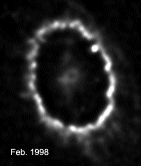 |
Figure 12. The inner ring around SN 1987A is
starting to light up due to the collision of the shock wave from the
supernova. The yellow areas in the picture on the right are where the
collisions are currently occurring. Image credit: P. Challis and R.
Kirshner (Harvard-Smithsonian Center for Astrophysics), P. Garnavich
(University of Notre Dame) and Z. Levay (STScI). |
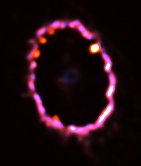 |
Here is a nifty animation showing the way that
SN 1987A and the rings have changed over time. First the supernova
happens, and after a while its energy lights up the ring as the light
passes through it. Then the ring gradually fades away. Then the ring
starts lighting up again, this time due to the collision of the shock
wave with the ring material. The ring and the shock wave are not nice
and neatly organized objects, so some parts of the ring will light up
before others. It will take some time for the collision to stop and the
ring to again fade away, but until then, it looks like a rather nice
show!
Now that you've read this section, you should be able to answer these questions....
- What are the various fusion processes that massive stars can go through?
- Why is each fusion process shorter than the previous one?
- What causes the core of a star to collapse?
- What happens during the core collapse?
- What are the important characteristics of supernovae?
- What are the characteristics of the two main types of supernovae that allow astronomers to tell them apart?
- What are hypernovae and how are they related to gamma-ray bursts?
- What information can be obtained from old supernova remnants?
- Why was SN1987A so important?
- What is currently happening to the environment around SN1987A?
 Figure 1.
A picture from the Hubble Space
telescope
showing stars in various stages of their lives. The lower right region
(1) is a gas cloud from which stars form. Near the center (2) is a
group of main sequence stars. Up and to the left of those is a large
star (3) in the process of dying. The massive star has already ejected
a ring of material as well as material out from it in a bipolar
direction. In a way this image is just like a family portrait showing
the oldest and youngest members of a family. Image credit: Wolfgang
Brandner (JPL/IPAC), Eva K. Grebel (Univ. Washington), You-Hua Chu
(Univ. Illinois Urbana-Champaign), and NASA.
Figure 1.
A picture from the Hubble Space
telescope
showing stars in various stages of their lives. The lower right region
(1) is a gas cloud from which stars form. Near the center (2) is a
group of main sequence stars. Up and to the left of those is a large
star (3) in the process of dying. The massive star has already ejected
a ring of material as well as material out from it in a bipolar
direction. In a way this image is just like a family portrait showing
the oldest and youngest members of a family. Image credit: Wolfgang
Brandner (JPL/IPAC), Eva K. Grebel (Univ. Washington), You-Hua Chu
(Univ. Illinois Urbana-Champaign), and NASA.







 and
H
and
H )
showing up prominently in its spectrum. Spectra for supernovae are available from
the
)
showing up prominently in its spectrum. Spectra for supernovae are available from
the 


 Figure 9.
Supernovae 1987A - image of the supernova at its brightest in the part
of the sky it appeared in. In the upper left of the image is the
Tarantula nebula, a large H II region. These objects are actually
thousands of light-years away - around 160,000 light-years in fact.
Image
Figure 9.
Supernovae 1987A - image of the supernova at its brightest in the part
of the sky it appeared in. In the upper left of the image is the
Tarantula nebula, a large H II region. These objects are actually
thousands of light-years away - around 160,000 light-years in fact.
Image  Figure 10.
The brightness variation of SN1987A over time. This chart shows
thousands of observations by both professional and amateur astronomers.
The time scale at the bottom is in days, but uses a rather strange
system. The entire graph covers a time corresponding to about 3.3
years. The magnitude scale is on the sides. Remember, the faintest that
you can see with your eye is magnitude 6, so SN1987A was visible to the
naked eye for about a year. Chart is courtesy of the American
Association of Variable Star Observers (AAVSO).
Figure 10.
The brightness variation of SN1987A over time. This chart shows
thousands of observations by both professional and amateur astronomers.
The time scale at the bottom is in days, but uses a rather strange
system. The entire graph covers a time corresponding to about 3.3
years. The magnitude scale is on the sides. Remember, the faintest that
you can see with your eye is magnitude 6, so SN1987A was visible to the
naked eye for about a year. Chart is courtesy of the American
Association of Variable Star Observers (AAVSO). Figure 11.
How the area around SN 1987A looks today. The supernova is in the
center
of the multi-ring structure. The inner ring is less than a light-year
from the supernova, while the other rings are a few light-years away.
The rings are not part of the supernova, but are made of material that
was blown out from the star before it went supernova. To see why the
rings have the orientation that they do, just click on
Figure 11.
How the area around SN 1987A looks today. The supernova is in the
center
of the multi-ring structure. The inner ring is less than a light-year
from the supernova, while the other rings are a few light-years away.
The rings are not part of the supernova, but are made of material that
was blown out from the star before it went supernova. To see why the
rings have the orientation that they do, just click on 
